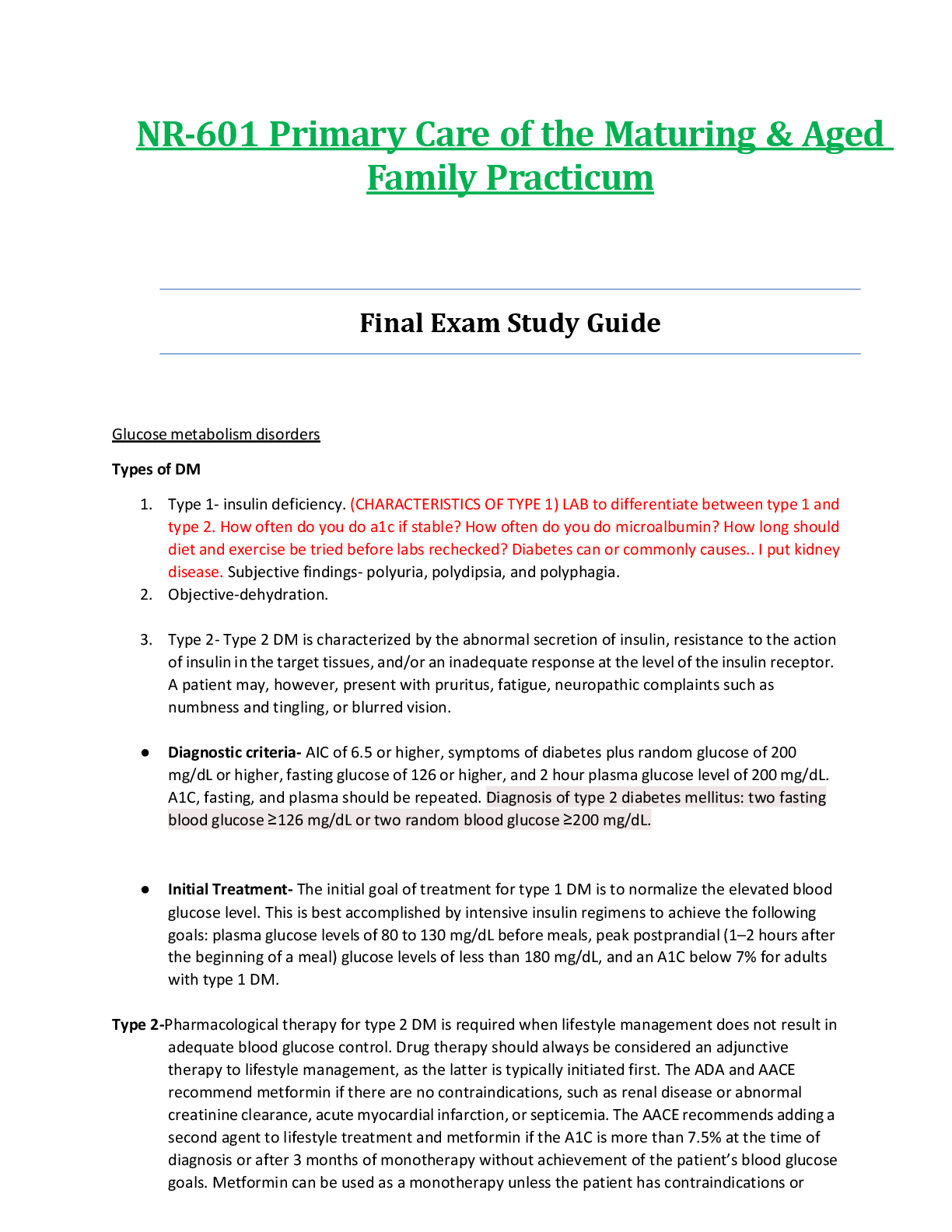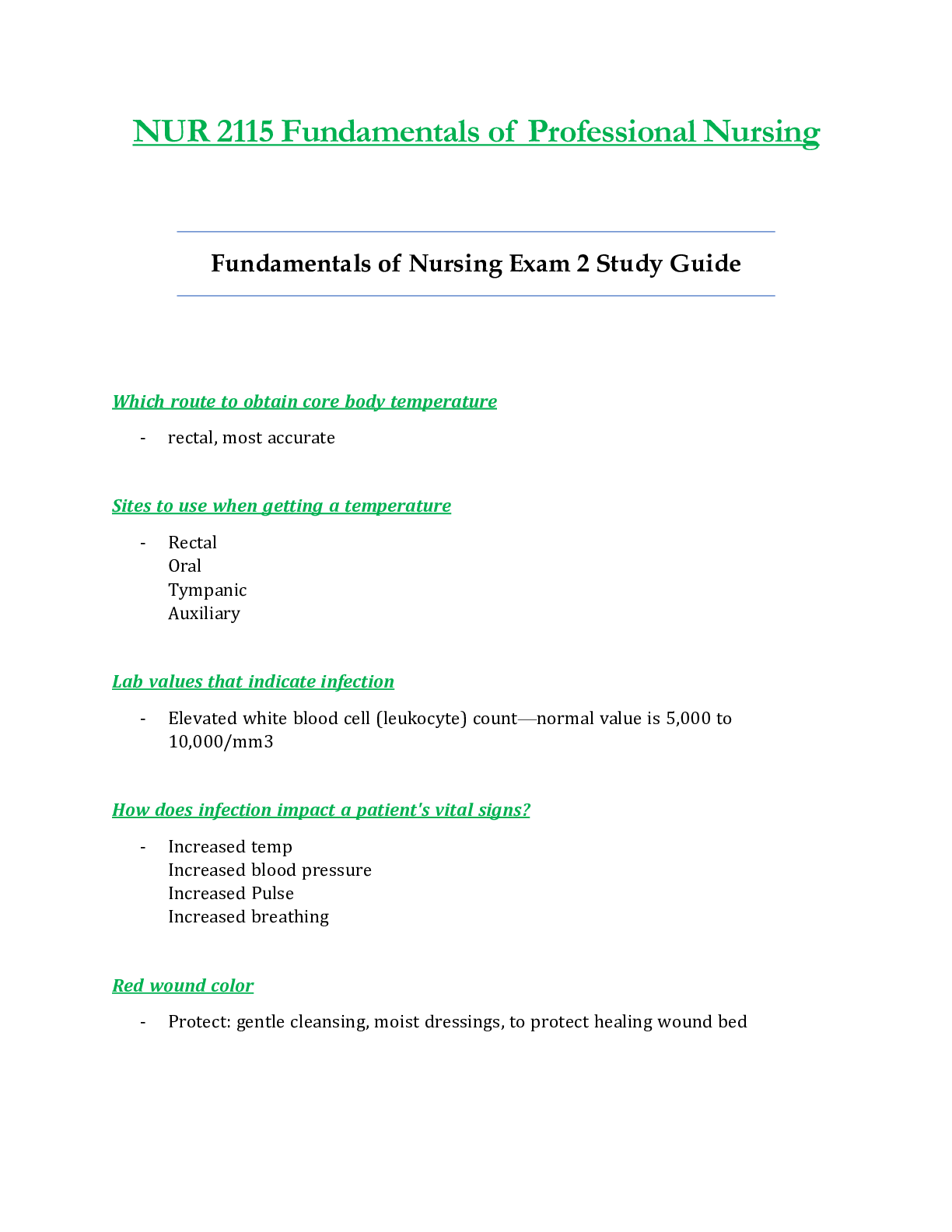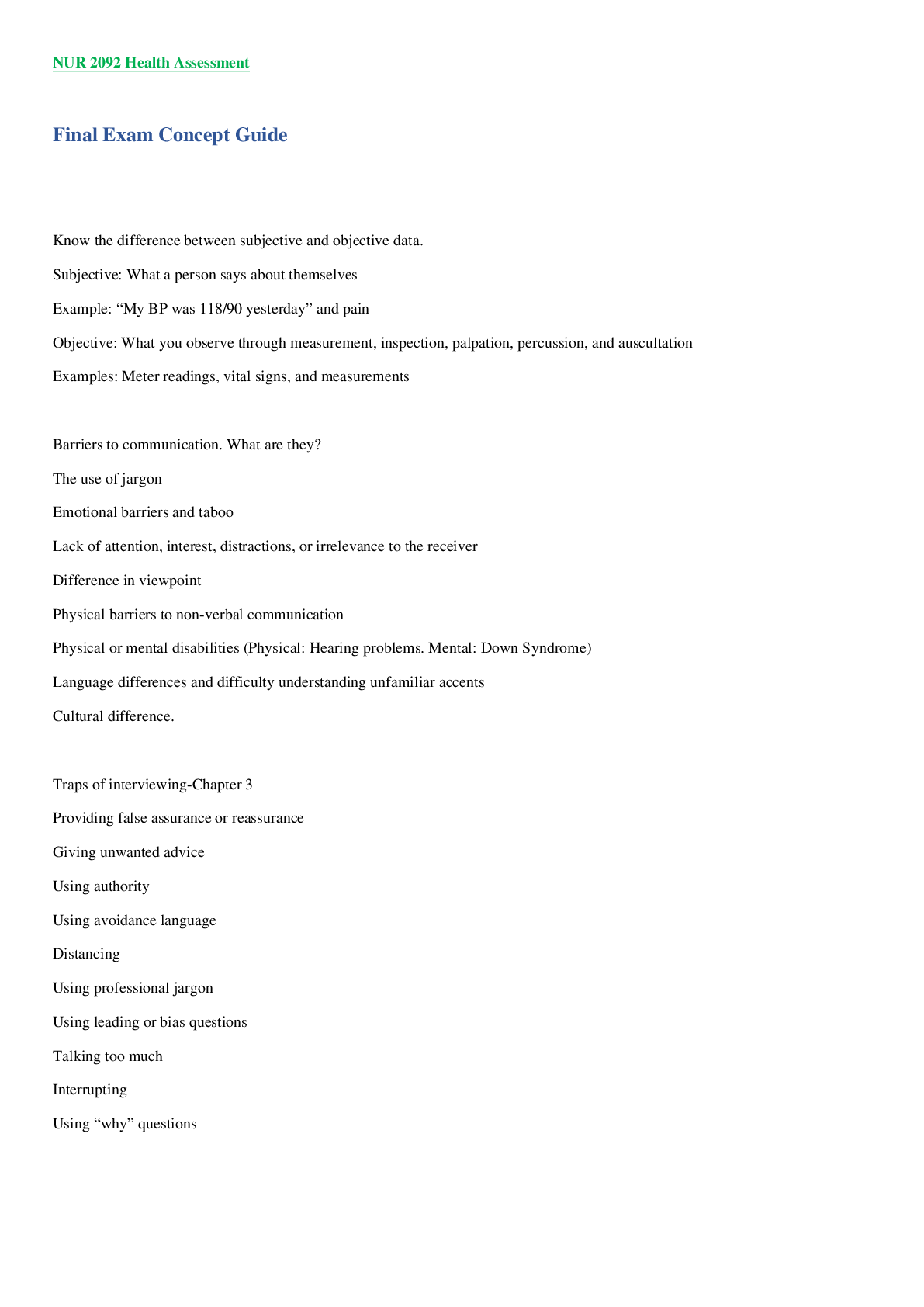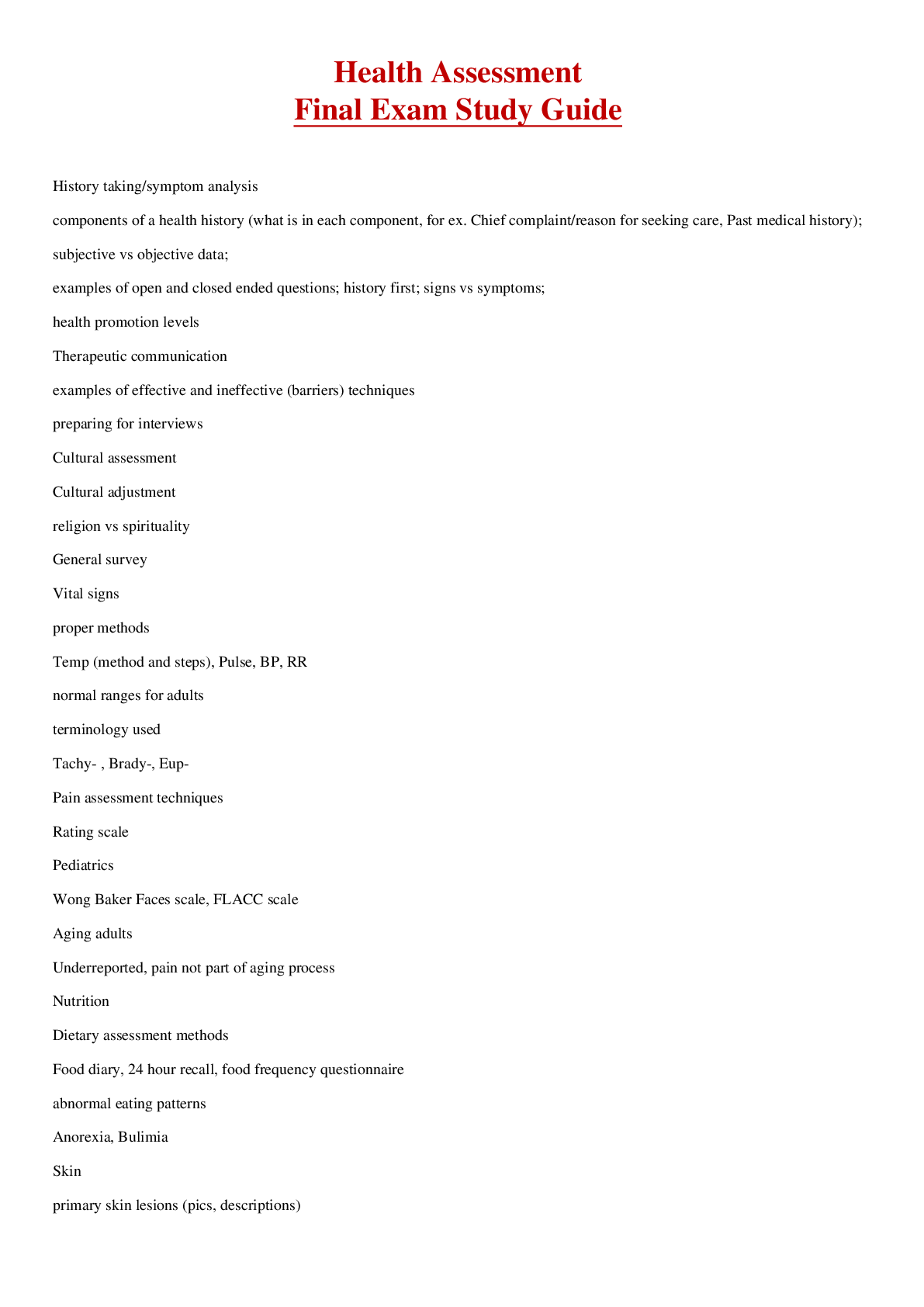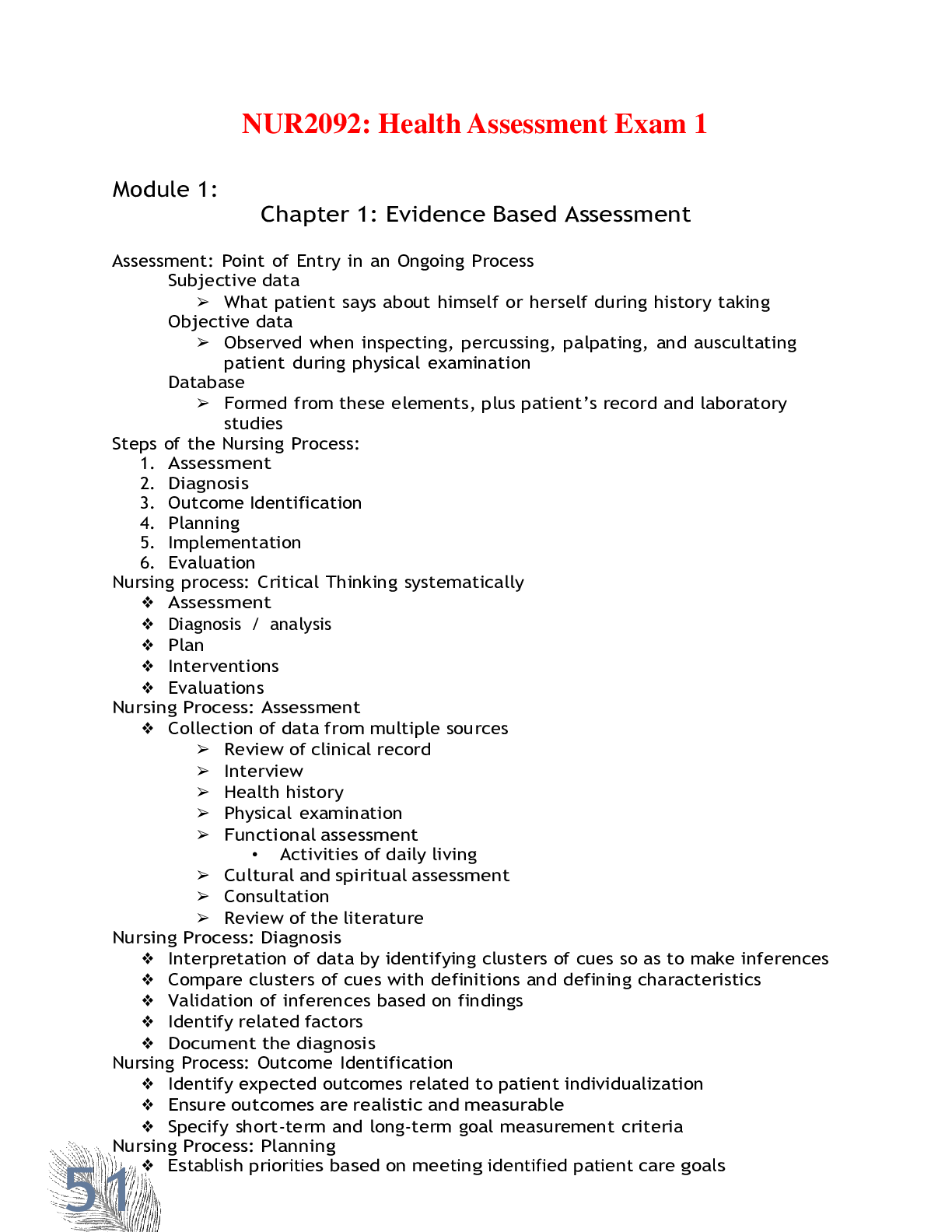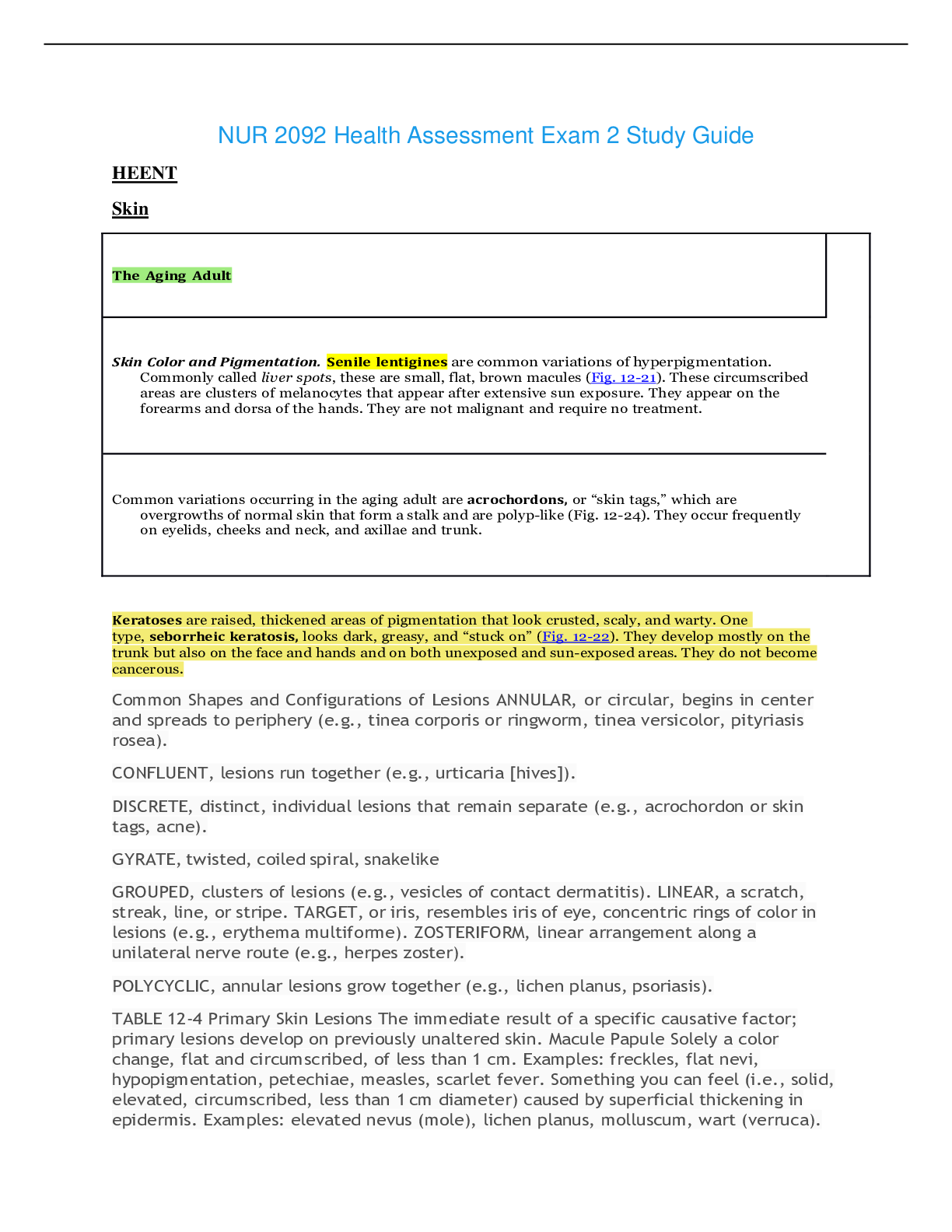*NURSING > STUDY GUIDE > NUR 2092 / NUR2092: Health Assessment Concept Guide Exam 1 Latest Update Rasmussen (All)
NUR 2092 / NUR2092: Health Assessment Concept Guide Exam 1 Latest Update Rasmussen
Document Content and Description Below
NUR 2092 Health Assessment Health Assessment Concept Guide Exam 1 1. Subjective and Objective Data - Subjective: Information perceived by the patient (symptoms). - Objective: Observable ... and measurable data that can be seen, heard, felt or measured by someone other than the person experiencing them (signs). 2. medication reconciliation - A procedure implemented by health care providers to maintain an accurate and up-to-date list of medications for all patients between all phases of health care delivery. 3. Purpose of health history - 4. Health Promotion Model - 5. Health Prevention - 6. Spiritual healers (faith healers) attempt to bring healing to a patient in which of the following ways: - 7. generalized anxiety disorder - 8. Ethnocentrism - 9. Culture - 10. Characteristics of Culture - 11. Ethnicity - 12. Assimilation - 13. acculturative stress - 14. Acculturation - 15. Stereotyping - 16. social learning - 17. Types of history taking (database) - 18. GAD - 19. Alert - 20. Lethargic - 21. Obtunded - 22. stupor or semi-coma - 23. Coma - 24. Global aphasia - 25. Broca aphasia - 26. Wernicke aphasia - 27. Public's concept of Health - 28. Main headings of mental status assessment - 29. Magicoreligious - 30. Naturalistic - 31. Subjective Data Collection - 32. objective data - 33. medication reconciliation - 34. Purpose of health history - 35. Allergy data recording - 36. Care of the limited English-speaking patient - 37. Problem priority levels - 38. sundown syndrome - 39. Delirium - 40. Dementia - 41. ADPIE • 42. x1: Oriented to Person - 43. x2: Oriented to Person and Place - 44. x3: Oriented - ... 45. The concept of health and healing has evolved in recent years. Which is the best description of health? - 46. Which would be included in the database for a new patient admission to a surgical unit? - 47. You are reviewing assessment data of a 45-year old patient and note pain of 8 on a scale of 10, labored breathing and pale skin on the EHR (electronic health record). This documentation is an example of? - 48. A patient is in the ER department with nausea and vomiting. Which would you include in the database? - 49. A patient recently received health insurance and would like to know how often he should visit the provider. How do you respond? - 50. You are reviewing concepts related to steps in the nursing process for determining prioritization and developing patient outcomes. To what are these actions attributed? - 51. Which best describes evidence-based nursing practice? - 52. What can be determined when the nurse clusters data as part of the critical-thinking process? - 53. A patient says she is very nervous and nauseated, and she feels as if she will vomit. What type of data would this be considered? - 54. The expert nurse differs from the novice nurse by acting without consciously thinking about the actions. This is referred to as: - 55. Which would be considered a risk diagnosis? - 56. Which would be included in a holistic model of assessment? - 57. The nurse uses health promotion activities with a new patient. What would this focus be? - 58. Which is an example of objective data? - 59. During the evaluation process phase of the nursing process, which action would be included? - 60. Which statement best describes religion? - 61. The major factor contributing to the need for cultural care nursing is: - 62. The term culturally competent implies that the nurse: - 63. You are the triage nurse in the ER and perform the initial intake assessment on a patient who does not speak English. Based on your understanding of linguistic competence, which action would present as a barrier to effective communication? - 64. What culture would describe illness as hot and cold imbalance? - 65. Of what makes the patient believe the amulet is protective? - 66. Which statement best illustrated the difference between religion and spirituality? - 67. The first step to cultural competency by a nurse is to: - 68. Which statement is true in regards to pain? - 69. Which factor is identified as a priority influence on a patient's health status? - 70. Which statement is most appropriate to use when initiating an assessment of cultural beliefs with an older American-Indian patient? - 71. Which statement best describes ethnocentrism? - 72. Which category is appropriate in a cultural assessment? - 73. Which belief practice is associated with patients who are of American-Indian heritage? - 74. Which statement best reflects the Magicoreligious causation of illness? - 75. The practitioner entering the examining room to meet a patient for the first-time states, "Hello Mr. S. I'm here to gather some information from you and to perform your exam. This will take about 30 mins. DD is a student working with me. If it's alright with you, she will remain during the exam. Which of the following must be added to cover all aspects of the contract? - 76. Empathy - 77. You conduct an admission interview. Because you are expecting a phone call, you stand near the door. Which would be a more appropriate approach? - 78. A patient asks the nurse, "may I ask you a question?" this is an example of: - 79. Which statement best describes interpretation as a communication technique? - 80. Which demonstrates a good understanding of the interviewing process? - 81. During an interview, a patient denies having any anxiety. The patient frequently changes position in the chair, holds his arms folded tight across his chest, and has little eye contact with the interviewer. The interviewer should: - 82. For what or with whom should touch be used during the interview? - 83. Children usually come for health care with a parent. At what age should interviewers begin to question the child presenting with symptoms? - 84. Because of adolescents’ developmental level, not all interviewing techniques can be used with them. Which technique should be avoided? - 85. Knowledge of the use of personal space is helpful. Personal distance is generally considered at: - 86. Mr. B tells you "everyone ignores me." You respond, "ignores you?" - 87. What does active listening NOT include? - 88. When interviewing a patient who doesn't speak English, the examiner should: - 89. With older adults, how should the examiner proceed with the interview? - 90. When reading a medical record, you see the following note: Patient states "I have had a cold for about a week and now am having difficulty breathing." This is an example of: - 91. You have reason to question the reliability of the information being provided by a patient. One way to verify the reliability within the context of the interview is to: - 92. The statement 'reason for seeking care' has replaced 'chief complaint' This change is significant because: - 93. During an initial interview, the examiner says, "Mr. J, tell me what you do when you headaches occur." This is an example of: - 94. Which is an appropriate recording of a patient's reason for seeking health care? - 95. Genogram - 96. What is the best description of 'review of symptoms' as a part of the health history? - 97. Which finding is considered to be subjective? - 98. When taking a health history for a child, what information in addition to that for an adult is usually obtained? - 99. Functional assessment measures how a person manages day-to-day activities. The impact of adoption on the daily activities of a child are referred to as: - 100. Which 2 sections of the child's health history become separate sections because of their importance to the child's current health status? - 101. Which assessment best describes the purpose of a health history? - 102. While assessing a man for allergies he states he is allergic to penicillin. Which response is best? - 103. Although a full mental status exam may not be required, you must be aware of the 4 main headings of the health assessment while performing the interview and physical exam. Theses headings are: - 104. Select the finding that most accurately describes appearance of a patient. - 105. You are assessing short-term cognitive function. Which assessment shows the ability to lay down new memories? - 106. You are preparing the discharge plan for a patient with aphasia. What assessment should you include in the plan? - 107. During an interview with a patient diagnosed with a seizure disorder, the patient states "I plan to be an airline pilot." If the patient continues to have this as a career goal after teaching regarding seizure disorder has been provided, you might question the patient's: - 108. On a patient's 2nd day in an acute care hospital, the patient complains about the 'bugs' on the bed. The bed is clean. This would be an example of: - 109. One way to assess the cognitive function and to screen for dementia is with: - 110. A major characteristic of dementia is? - 111. What statement is an example of a patient with dysarthria? - 112. You are leading a discussion of the planned activities for the day at an adult living center and state: "we will be having snacks at 9:30 and lunch at noon." One participant responds in a monotone manner 'snacks at 9:30 and lunch at noon. Snacks at 9:30 and lunch at noon.' The patient is exhibiting signs of: - 113. You are performing a mental status exam. Which assessment would be most appropriate? - 114. What is a priority assessment for aging adults? - 115. You are assessing a 75-year old man. What is an expected finding? - 116. When assessing mental status in children, what statement is true? - 117. Common North America disease - 118. Categories of the cultural assessment - 119. Hot & Cold Theory - 120. 4 Humor Theory - 121. Spirituality - 122. Note taking draw backs - 123. Nonverbal cues - 124. 10 Traps of interviewing - 125. Adolescent interviewing - 126. Past Medical History (PMH) - 127. Sign - 128. Symptoms - 129. What is included in a health history? - 130. What is a history source? - 131. What make them reliable? - 132. closed-ended questions - 133. open-ended questions - 134. CAGE assessment - 135. Unrelated words test - 136. Denver II screening test - 137. MMSE - 138. Mini-Cog Test - 139. PQRSTU - 140. first, second, third priority level problems - 141. Review of Systems (ROS) - 142. Types of history taking - 143. Functional assessment for the adult - 144. Functional assessment for the child - 145. Affect - 146. Suicide attempt risk - 147. Hallucinations - 148. Depression - 149. compulsive disorder - 150. social disorder - 151. Post-Traumatic Stress Disorder - 152. generalized anxiety disorder - 153. levels of consciousness (LOC) - 154. ADPIE - 155. Orientation status - Orientation Levels - 156. Main headings of mental status assessment - 157. Magicoreligious - 158. Biomedical - 159. Naturalistic - [Show More]
Last updated: 2 years ago
Preview 1 out of 17 pages

Buy this document to get the full access instantly
Instant Download Access after purchase
Buy NowInstant download
We Accept:

Reviews( 0 )
$12.00
Can't find what you want? Try our AI powered Search
Document information
Connected school, study & course
About the document
Uploaded On
Nov 09, 2020
Number of pages
17
Written in
Additional information
This document has been written for:
Uploaded
Nov 09, 2020
Downloads
0
Views
140


